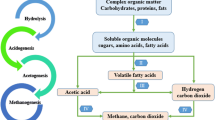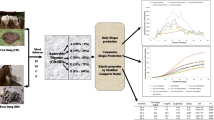Abstract
In this study, biogas production from co-digestion of pig dung, water hyacinth, and poultry droppings was investigated. 500 ml bio-digesters were connected in series and water displacement method was used to estimate the amount of biogas produced. The ratio of the percentage weight distribution of pig dung to water hyacinth to poultry dropping was varied as: (0:40:60), (30:40:30), (15:40:45), (45:40:15), and (60:40:0) in digesters A1, B2, C3, D4 and E5, respectively. The highest biogas cumulative yield of 307 cm3 CH4/g was obtained in Digester C3. The gas chromatography analysis showed 22.50 wt% (CO2), 64.92 wt% (CH4) and 4.83 wt% (N2) which implied that the biogas produced can be used for cooking and heating of homes in rural and urban communities.




Similar content being viewed by others
References
Abdeshahian P, Lim JS, Ho WS, et al. Potential of biogas production from farm animal waste in malaysia. Renew Sustain Energy Rev. 2016;60:714–23.
Alfa I, Dahunsi S, Iorhemen O, et al. Comparative evaluation of biogas production from Poultry droppings, Cow dung and Lemon grass. Bioresour Technol. 2014;157:270–7.
American Society for Testing and Materials. Standard test methods for moisture in activated carbon. Philadelphia: ASTM Committee on Standards; 1991.
Anozie A, Layokun S, Okeke C. An evaluation of a batch pilot-scale digester for gas production from agricultural wastes. Energy Sources Part A. 2005;27:1301–11.
APHA. Standard methods for examination of water and wastewater. 18th ed. Washington, DC, USA: Public health Association; 1995.
Aritra D, Chanchal M (2015) Comparative kinetic study of anaerobic treatment of thermally pretreated source -sorted organic market refuse. https://doi.org/10.1155/2015/684749
Bayer EA, Lamed R, Himmel ME. The potential of cellulases and cellulosomes for cellulosic waste management. Curr Opin Biotechnol. 2007;18:237–45.
Chen G, Zheng Z, Yang S, et al. Improving conversion of Spartina alterniflora into biogas by co-digestion with cow fece. Fuel Process Technol. 2010;91:1416–21.
Cirne DG, Paloumet X, Bjornsson L, et al. Anaerobic digestion of lipid-rich waste: effects of lipid concentration. Renew Energy. 2007;32:965–75.
Elenwo EI, Akankali JA. The Estimation of Potential Yield of Water Hyacinth: a Tool for Environmental Management and an Economic Resource for the Niger Delta Region. J Sustain Dev Stud. 2016;9(2):115–27.
Graaf D, Fendler R (2010) Biogas production in Germany. Federal Environment Agency, p 29.
Itodo IN, Awulu JO, Philip T. A comparative analysis of biogas yield from poultry, cattle and piggery wastes. Af J Environ Stud. 2000;2(1):152–4.
Iyagba ET, Mangibo IA, Mohammadd YS. The study of cow dung as co-substrate with rice husk in biogas production. Sci Res Essay V1. 2009;4(9):861–6.
Kaster AK, Goenrich M, Seedorf H, et al. More than 200 genes required for methane formation from H2 and CO2 and energy conservation are present in Methanothermobacter marburgensis and Methanothermobacter thermautotrophicus. Archaea. 2001. https://doi.org/10.1155/2011/973848.
Lehtomäki A, Huttunen S, Rintala JA. Laboratory investigations on co-digestion of energy crops and crop residues with cow manure for methane production: effect of crop to manure ratio. Resour Conserv Recycl. 2007;51(3):591–609.
Li J, Jha AK, He J, et al. Assessment of the effects of dry anaerobic co-digestion of cow dung with waste water sludge on biogas yield and biodegradability. Int J Phys Sci. 2011;6(15):3723–32.
Lima DMF, Rodrigues JAD, Boe K, et al. Anaerobic modeling for improving synergy and robustness of a manure co-digestion process. Braz J Chem Eng. 2016;33(4): 33(4):871–83.
Mata-Alvarez J, Dosta J, Romero-Güiza MS, et al. A critical review on anaerobic co-digestion achievements between 2010 and 2013. Renew Sustain Energy Rev. 2014;36:412–27.
Mshandete AM, Parawira W. Biogas technology research in selected sub-saharan african countries a review. Afr J Biotech. 2009;8:116–25.
Mudhoo A, Kumar S. Effects of heavy metals as stress factors on anaerobic digestion processes and biogas production from biomass Int. J Environ Sci Technol. 2013;10:1383–98.
Okewale AO, Babayemi K, Adesina OA. Biogas production from anaerobic co-digestion of corn cobs, pig and poultry droppings. J Engine Res Dev. 2018;1(2):273–82.
Oloko-Obba M, Taiwo E, Ajala SO, et al. Performance evaluation of three different-shaped bio-digesters for biogas production and optimization by artificial neural network integrated with genetic algorith. Sustai Energy Technol Assess. 2018;26:116–24.
Owamah H, Alfa M, Dahunsi S. Optimization of biogas from chicken droppings with Cymbopogon citratus. Renew Energy. 2014;68:366–71.
Parawira W, Murto M, Zvauya R, et al. Anaerobic digestion of solid potato waste alone and in combination with sugar beet leaves. Renew Energy. 2004;29:1811–23.
Ramansu G, Pritam C, Sambhu Nath S, et al. An overview of physicochemical mechanisms of biogas production by microbial communities: a step towards sustainable waste management. Biotech. 2016;6(1):72. https://doi.org/10.1007/s13205-016-0395-9.
Reungsang A, Pattra S, Sittijunda S. Optimization of key factors affecting methane production from acidic effluent coming from the sugarcane juice hydrogen fermentation process. Energies. 2012;5:4746–57.
Sawatdeenarunat C, Surendra KC, Takara D, et al. Anaerobic digestion of lignocellulosic biomass: challenges and opportunities. Bioresour Technol. 2015;178:178–86.
Sittijunda S. Biogas production from hydrolysate Napier grass by co-digestion with slaughterhouse waste water using anaerobic mixed culltures. KKU Res J. 2015;20:323–36.
Tufaner F, Avşar Y. Effects of co-substrate on biogas production from cattle manure: a review Int. J Environ Sci Technol. 2016;13:2303–12.
Wang X, Yang G, Feng Y, et al. Optimizing feeding composition and carbon–nitrogen ratios for improved methane yield during anaerobic co-digestion of dairy, chicken manure and wheat straw. Biores Technol. 2012;120:78–83.
Wellinger A, Murphy JD, Baxter D. The biogas handbook: science, production and applications. Cambridge: Elsevier; 2013.
Ye J, Li D, Sun Y, et al. Improved biogas production from rice straw by co-digestion with kitchen waste and pig manure. Waste Manag. 2013;33(12):2653–8.
Author information
Authors and Affiliations
Corresponding author
Ethics declarations
Conflict of interest
The authors declare that they have no conflict of interest.
Additional information
Publisher's Note
Springer Nature remains neutral with regard to jurisdictional claims in published maps and institutional affiliations.
Rights and permissions
About this article
Cite this article
Okewale, A.O., Adesina, O.A. Evaluation of biogas production from co-digestion of pig dung, water hyacinth and poultry droppings. Waste Dispos. Sustain. Energy 1, 271–277 (2019). https://doi.org/10.1007/s42768-019-00018-8
Received:
Revised:
Accepted:
Published:
Issue Date:
DOI: https://doi.org/10.1007/s42768-019-00018-8




